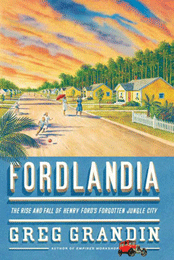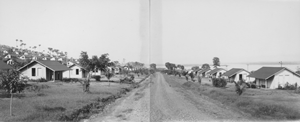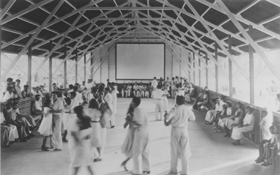Henry Ford’s Jungle Dystopia
Air Date: Week of June 12, 2009

Author Greg Grandin explores Henry Ford’s Amazon experiment in his new book.
Henry Ford wanted to export rubber out of the Amazon and import a little America into it. But his famed assembly line failed horribly in the forest, and his ideas on clean, healthy living were not exactly shared by his Brazilian workers. Greg Grandin, author of Fordlandia, tells host Steve Curwood about the rise and fall of Henry Ford’s forgotten jungle city.
Transcript
CURWOOD: World War II touched nearly every continent. And while few guns were fired in South America, there was fierce competition for hearts, minds and resources.
A top strategic item: rubber. The Japanese controlled the Asian sources, but as a 1944 war propaganda film declared, a key chunk of the Amazon and its rubber trees were already in the hands of America’s leading industrialist.
FILM: Among the present day pioneers of the Amazon who are lighting the way for others to follow is Henry Ford. Ford’s rubber development on the Topajoz River is an enterprise of historic proportion.
CURWOOD: Mr. Ford’s rubber development was known as Fordlandia.
Fordlandia is also the title of Greg Grandin’s book in which he explains why Ford Motors set up shop in the Amazon many years before World War Two broke out:
GRANDIN: Henry Ford by 1927 by the time he acquired a land grant from the Brazilian government, by that point he presided over the largest industrial empire in the world, he was one of the richest man in history. The only thing that was missing, the one thing he didn’t have control over was latex, was rubber.
CURWOOD: So Mr. Ford - who was famous for overcoming almost any obstacle - set about converting a piece of the rubber-rich Amazon into a source of supply and a bit of middle America.
Greg Grandin describes what an observer paddling up the river to Fordlandia would have seen.
[SPLASHING SOUNDS]
GRANDIN: The first thing you would see would be an enormous water tower with the Ford cursive logo on it. At the time in the 1920s, late 1920s, early 1930s, it was the tallest manmade building in the Amazon. You would get off the boat and to the left you would see a bunch of small workers bungalows, not unlike you would find in mill towns in the United States. Maybe half a mile in from the river you would see an industrial plant, a power house, a sawmill, a state of the art sawmill, and then a little bit further you’d find the American neighborhood, the American zone, with three or four room houses with porches. They weren’t too ostentatious, they were properly Protestant, it looked like something out of the Midwest.

Workers’ bungalows were built after an American style.
CURWOOD: But there’s a reason this film, produced by the Disney studio for the war effort, is considered propaganda - truth was a casualty. It turns out that from the beginning, Fordlandia was someplace between a disaster and a calamity.
Again, Greg Grandin.
GRANDIN: The great thing about this story is that it brings together two extremes. Henry Ford on the one hand and the Amazon on the other—you really got an epic clash of opposites. So at one point he famously calculated that it took 7,882 distinct tasks to make a Model T. But of course the Amazon is a place where 7,882 organisms could be found on any given 5 acres. It’s the most diverse ecological system on the planet—one that moved not toward simplicity but toward the height of complexity. So you put these two things together and what you get is a story that is almost Chaplin-esque in its absurdity.
CURWOOD: Henry Ford’s managers and engineers, trained in the precision and discipline of his factory’s assembly lines, weren’t equipped to work in the sweltering rainforest. Nor did they understand the culture of the Amazon.
GRANDIN: Setting up the plantation at first and carving out the settlement out of the jungle was hard and often deadly work. Managers showed up from Dearborn, from the upper peninsula in Michigan, and they had no, they didn’t speak Portuguese, they didn’t know much about local customs or certainly local labor relations. And reports came out of the jungle that the settlement was sinking into kind of like a cesspool of waste and violence and vice. Workers fled from the construction site and they brought with them tales of knife fights of riots and strikes, of Ford managers that defrauded them of pay and also they didn’t know what they were doing in terms of how to clear jungle and turned the forest into a mudhole, burning large swaths of the jungle without the slightest idea of how to plant rubber.
CURWOOD: Still, despite the setbacks, the Ford Industrial Machine did get the settlement built – a little slice of Michigan in the jungle and the rubber began to trickle out.
But the culture clash did not disappear, and Ford’s ideas didn’t jibe with his Brazilian employees. Yes, they tolerated the rigid work schedule and they coped with their obligatory shoes. They even put up with Henry Ford’s passion for square dancing and the “Old Time Dance Orchestra” music recorded by Mr. Ford’s good friend Thomas Edison that was broadcast over loudspeakers throughout Fordlandia.
[SQUARE DANCING MUSIC]

In the midst of the jazz era, Henry Ford was an ardent traditional dance hold-out. He insisted his workers enjoy this old fashioned music as well.
GRANDIN: Workers rioted. They didn’t, they weren’t interested in eating brown rice or whole wheat bread and December 22, 1930 there was an enormous riot that almost destroyed all of Fordlandia. Overturned trucks and threw equipment into the river and broke windows. The American managers had to flee into the jungle or flee by boat into the river and the Brazilian army had to come in to suppress the riot.
CURWOOD: The town was rebuilt after that – and Disney’s film celebrated Fordlandia as a marvel of modernity and the American way.
FILM: Science and skill work hand in hand to produce the finest rubber trees possible. Scientific care, the watchword of the plantation, is extended to the human element to.
Today the Ford Plantation is a successful enterprise, a tribute to skill and science. The new weapons of the 20th century pioneer.
CURWOOD: But soon after the weapons of war were laid down in 1945, Ford Motors sold Fordlandia back to the Brazilian government for pennies on the dollar. It may well be that peace – and the invention of synthetic rubber doomed Fordlandia.
But at least as responsible - if not more so - was Ford’s vision of an American utopia in the Amazon. Fordlandia is still standing today. And though Henry Ford himself never visited his unsustainable utopia - Greg Grandin has been there.
GRANDIN: It’s a small town, a little forlorn. Brazilians still live in the old worker bungalows that Ford had set up for the rubber workers. The American town is completely abandoned, given over to the jungle.

Much of Fordlandia has fallen to disrepair.
[Whistle]
Here you are in the middle of the Amazon and there’s certainly no work to go to and you hear the factory whistle blow in the morning.
[Whistle]
And it still marks time for many of the inhabitants who live in Fordlandia.
CURWOOD: So Greg, why did you write this book?
GRANDIN: I wrote the book because I think the story of Fordlandia captures something specific or particular about U.S.’s sense of itself. Ford’s obsession with raising America in the Amazon had almost nothing to do with the Amazon itself. The more Fordlandia failed on its own terms, that is, to grow rubber, the more the project was justified in idealistic terms as a civilizing mission and I think that that resonates with today.
CURWOOD: Greg Grandin’s book is called “Fordlandia: the Rise and fall of Henry Ford’s forgotten jungle city.”
[MUSIC] Bing Crosby & The Andrews Sisters “South America Take it Away” from Bing Crosby & the Andrews Sisters: Their Complete Recordings Together (MCA 1952)
Links
Thomas Edison recorded Henry Ford's favorite square-dance tune.
Living on Earth wants to hear from you!
Living on Earth
62 Calef Highway, Suite 212
Lee, NH 03861
Telephone: 617-287-4121
E-mail: comments@loe.org
Newsletter [Click here]
Donate to Living on Earth!
Living on Earth is an independent media program and relies entirely on contributions from listeners and institutions supporting public service. Please donate now to preserve an independent environmental voice.
NewsletterLiving on Earth offers a weekly delivery of the show's rundown to your mailbox. Sign up for our newsletter today!
 Sailors For The Sea: Be the change you want to sea.
Sailors For The Sea: Be the change you want to sea.
 The Grantham Foundation for the Protection of the Environment: Committed to protecting and improving the health of the global environment.
The Grantham Foundation for the Protection of the Environment: Committed to protecting and improving the health of the global environment.
 Contribute to Living on Earth and receive, as our gift to you, an archival print of one of Mark Seth Lender's extraordinary wildlife photographs. Follow the link to see Mark's current collection of photographs.
Contribute to Living on Earth and receive, as our gift to you, an archival print of one of Mark Seth Lender's extraordinary wildlife photographs. Follow the link to see Mark's current collection of photographs.
 Buy a signed copy of Mark Seth Lender's book Smeagull the Seagull & support Living on Earth
Buy a signed copy of Mark Seth Lender's book Smeagull the Seagull & support Living on Earth

